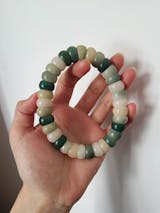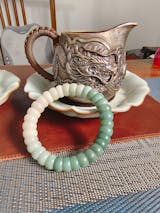Discover the beauty of traditional Chinese craftsmanship with this
premium pair of hand-polished wenwan walnuts. These walnuts are carefully selected for their symmetry, density, and intricate natural textures.
Perfectly suited for
hand exercises,
stress relief,
meditation, and as a collectible piece, these walnuts offer a tactile experience that enhances circulation and brings a sense of calm. The subtle pointed tip style ensures a firm and comfortable grip during daily use. Whether you're a seasoned collector or a beginner exploring the world of traditional Chinese handcrafts, this walnut pair is an exceptional piece to treasure or gift.
Features:
Material: Natural, high-density walnut
Style: Apple Round Shape, Four-Pillar Lion Head Texture, Kylin Pattern Official Hat Design
Polish: Expertly hand-polished for a smooth, glossy finish
Usage: Hand therapy, meditation, stress relief, traditional art collection
Cultural Significance: Symbolizes good fortune, strength, and protection in Chinese tradition
What Are Wenwan Walnuts?
Wenwan walnuts, also known as hand-playing walnuts, are different from ordinary edible walnuts. They come from specially cultivated or naturally occurring walnut varieties known for their hard shells, elegant textures, and symmetrical shapes. Over time and with frequent handling, they develop a glossy surface, gradually darkening from light yellow to deep red, with a smooth, porcelain- or agate-like finish.
Besides their aesthetic value, Wenwan walnuts also provide health benefits. According to Traditional Chinese Medicine, rolling walnuts in the palms helps stimulate acupressure points, improve circulation, and support internal organ function. They are especially beneficial for people who sit for long hours or are middle-aged and elderly.
The Four Stages of Wenwan Walnut Polishing
Stage 1: Priming (Base Preparation)
This is the foundational stage where the raw walnuts are thoroughly cleaned and brushed to remove the white alkali layer on the surface. This “priming” process helps the skin begin to show its natural tone—usually a light yellow—and gives the walnuts a subtle early shine, setting the stage for further polishing and color development.
Stage 2: Glazing
With continuous handling and brushing, the walnuts will become glossier—a process known among experienced players as "gua ci", or surface glazing. This stage prepares the walnuts for deeper color development and more even patina in the next phases. Tip: many enthusiasts use a nano brush for effective and gentle cleaning.
Stage 3: Patina Formation
In this stage, the walnuts begin to develop a patina by absorbing the natural oils and sweat from your hands during play. It's important to follow the golden rule: 70% brushing, 30% handling. Some deeper crevices may not color evenly, so brushing is essential to distribute the patina smoothly. Over time, the walnuts shift from yellow to deep brown, then gradually turn red. If you want a rich, glossy red tone, frequent brushing is key—otherwise, the color may lean toward a dark soy-sauce hue.
Stage 4: Jade-like Finish
After a long period of care and conditioning, the walnuts may reach the most coveted stage: "Yu Hua", or jade-like transformation. At this point, the surface appears glossy, translucent, and smooth to the touch—just like jade. Under the light, they shine with a reddish glow and a refined texture. This is considered the ultimate achievement by Wenwan masters.

















































































